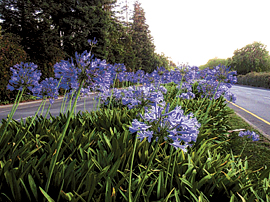The agapathus africanus, commonly called Lily of the Nile is native to South Africa. The name agapanthus is derived from the Greek word agape, meaning love, and anothos meaning flower. The ‘Flower of Love’ is exemplified in its use in tropical landscapes throughout the world, and most importantly southwest Florida. The Lily of the Nile produces a beautiful cluster of blue, funnel shaped flowers, with a large leafless stalk that rises from 18 to 24″ above the mound of grass like leaves. These plants can also come in a white variety, and blooms from June to July. These perennial flowers do best in full sun/partial shade, well drained and rich soil.
The Lily of the Nile does best in USDA hardiness zones 9 through 11. Southwest Florida hosts a perfect climate to use this species in masses in your garden. This plant creates a unique accent of colors to your garden and is highly attractive to hummingbirds and pollinating insects.
The Lily of the Nile is a species of flower that has a unique history in traditional medicine from the region they originated from. It is believed this species is a plant of fertility and pregnancy. Women would take the plant in various forms of medicines as well as wearing the flower and plant. It was believed it would act as a charm to bring strong and healthy babies. Medicinally, the lily would be used to treat heart disease, paralysis, coughs, chest pains and chest tightness. This plant also was thought to have magical qualities as it was believed to ward off thunder.
The Lily of the Nile with its exotic name will make an equally exotic statement in your landscape. There are not many flowers in our palette that have this rich beautiful blue color in such a dramatic size bloom. Enjoy.
This plant column is a joint effort by all at In The Garden, a Sanibel garden center located at 3889 Sanibel Captiva Road, Sanibel.
